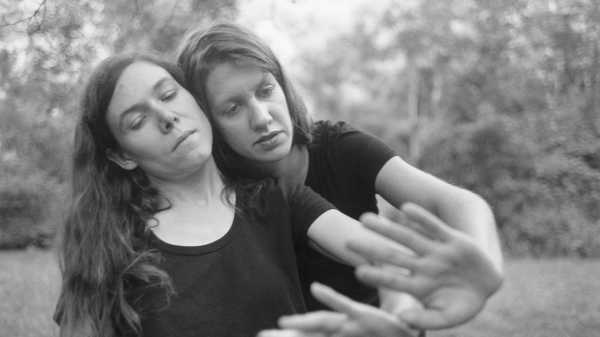
Anna & Elizabeth is a band whose name is a nod to Hazel & Alice, the
all-woman bluegrass duo that was recorded on the Smithsonian Folkways
label at a time in the mid-sixties when the bluegrass musicians being
recorded were almost all men. Like Hazel Dickens and Alice Gerrard, Anna
Roberts-Gevalt and Elizabeth LaPrelle met in the South, where LaPrelle
grew up and, even as a teen-ager, sang famously beautiful versions of
old songs, such as “Pretty Saro” and “Matty Groves.” Roberts-Gevalt grew up
in Vermont. In college, she fell in love with fiddle music and all the
Folkways recordings. As soon as she graduated, she moved to southwestern
Virginia to learn banjo, which is where she met LaPrelle.
The duo’s début album, released in 2016, was a spare collection of Southern
folk songs, their harmonies tight and beautiful, backed by LaPrelle’s
banjo and Roberts-Gevalt’s clawhammer guitar. On that first effort, one
old song ventured north of the Mason-Dixon Line, or almost did: “Going
Cross the Mountain” tells of a man from the South who goes to fight for
the Union. That song turns out to be a preface, in retrospect, for “The
Invisible Comes to Us,” Anna & Elizabeth’s sophomore effort, which
includes some Southern songs but mostly Northern ones—a kind of surprise
for both artists, especially the one from the North.
The Northern songs stem from what might be called the duo’s
musicological investigations of place, through both sound and visual
representations. Roberts-Gevalt and LaPrelle are known for their
hypnotic use of moving panoramas called “crankies.” Crankies
consist of illustrated scrolls, wound onto spools. They are then
cranked, and the audience experiences one long, moving picture, a
ribbon-like illustration of, in the duo’s case, old ballads. Yes,
crankies are for kids. “Do you want to sit through a five-minute ballad,
you kindergarteners?” LaPrelle said in an interview, a while back. “You
will if there’s a crankie.”
Roberts-Gevalt and LaPrelle turn their painted or embroidered scrolls
through a crankie that is the size of a small flat-screen TV, but,
historically, crankies have been as large as theatre stages, depicting
whaling voyages, or river journeys, or trips around the world. Over the
past few years, the duo has experimented with their crankies, using them
to tell not just the stories of the songs but also the stories of people
they met while collecting the songs. In so doing, they have worked
through some of the questions that their new album now considers: What
can a song from the past tell us? And, more specifically, what can it
help us to feel?
The songs on the new record that are Northern partly arise from
Roberts-Gevalt’s previous touring experiences. “Part of making this
record and doing this research,” she told me, “was out of a little bit
of annoyance, especially after doing so many tours, being in New
England, and having people say, ‘Oh, wow, this authentic Southern
music!’ And I was thinking, Yes, it is authentic. However, there is this
music in your back yard, and you could learn about it now.”
Rather than scold, Roberts-Gevalt did her own homework. She subsequently
discovered “Jeano and Jeannette,” the album’s opening track, in Vermont,
in the Middlebury College archives, home to the song collection of Helen
Hartness Flanders. Beginning in 1930, Flanders, as the director of the
Committee on Traditions and Ideals of the Vermont Commission on Country
Life, collected and archived close to five thousand song samples from
around New England.
Margaret Shipman sang “Jeano and Jeanette” for Flanders on September 5,
1941, at her home in Lee, Massachusetts, in the Berkshires (part of the
Appalachians, by the way), where Shipman lived with her two sisters. If
song collecting were like mining, then this song would be gold. In the
song as Shipman sings it, the singer is worried about Jeano, Jeannette’s
love, going to war, about him forgetting her, and Roberts-Gevalt and
LaPrelle sing it hurt but strong: “But my heart will be with you,
wherever you may go, can you look me in the face and say the same,
Jeano.” Then the chorus, an old refrain, which has been refashioned
slightly:
If I were Queen of France, or still better Pope of Rome,
I’d have no fighting men abroad, nor weeping maids at home.
All the world should be at peace, and the right should be the might,
I’d have those that made the quarrelling the only ones to fight.
Then we hear a swell of brass and organ, with a soundscape made up of
shorebirds and the ocean, bells and percussions, that gradually fades
away, though the song itself is reprised at the end, when (spoiler
alert!) Shipman herself sings.
Soundscapes are what Anna & Elizabeth are shooting for on this beautiful
album. They sing so-called folk songs, but they use the arsenal of various
musical genres—including jazz and avant-garde —to set these songs down
in fields of breathy reeds (or, on several tracks, in the mind-bending
playing of Susan Alcorn, the renowned pedal-steel-guitar player from
Baltimore). Of late, old-time traditional music has functioned as a
nexus for experimentation—Sam Amidon’s records are a recent
example, though John Cage’s work with Irish traditional musicians is an earlier
one—and it’s fitting that Anna & Elizabeth are releasing their album on
Folkways in the year of the label’s seventieth anniversary. The label’s
catalogue includes much of the song collecting of John Lomax, recordings
by Cage, and soundscapes by the likes of Tony Schwartz, who taped street
sounds in his Manhattan neighborhood: children playing, grocers talking,
street musicians. Folkways sees “The Invisible Comes to Us” as a
future-facing album, and it is—especially in the way the album begins, if
ever so gently, to confront the biases built into our archives of
American music.
Scholars have noted that the selling of Southern music as the one true
roots music goes hand in hand with the South’s attempt to cast itself as
the center of “heritage.” “Southern folk music’s overwhelming
dominance—for all its championing by non-Southern liberals—also subtly
reinforces the ‘heritage not hate’ defenses of the Confederate flag and
other antebellum and pre–civil rights nostalgia,” Josh Garrett-Davis,
the Gamble assistant curator at the Autry Museum of the American West,
wrote recently. This cultural rebranding began after the North withdrew
its troops, and the South, in destroying the apparatus of Northern
occupation, played down slavery, and played up history and states’
rights.
And yet, as with nearly everything having to do with racism in the U.S.,
the North was (and still is) complicit. In Vermont, the Commission on Country Life, for which
Flanders initially collected, was a committee set up to celebrate
patriotism and the purity of the Vermont countryside at a time when
immigrants and poor workers (“degenerates,” as the eugenics-oriented
commission described them) were “polluting” the rural landscape—i.e.,
Catholic French-Canadians, Irish communities, Italians,
Scandinavians, and, especially, the Abenaki, the local Native Americans.
This does not mean that Flanders didn’t do great work as a collector.
She did, while fighting gender stereotypes, and mastering technologies
that were typically off limits to women at that time. She was also,
eventually, persuaded by colleagues to collect some songs that were
tainted with the Catholicism of the “degenerates.” Given these
histories, it is essential to look hard at the Flanders archive and at
the specifics it offers, to reimagine the textures of migrations and
lost landscapes—and with the song “Farewell to Erin,” Anna & Elizabeth
deftly manage some of this essential reimagining.
The song was, the Smithsonian reports, recorded by John Lomax and sung
by Carrie Grover of Gorham, Maine. Grover was born in 1879, in Black River, Nova Scotia, to a musical family
with English, Irish, Scottish, and Welsh roots. As a child, Gorham heard
a relative say that when her family died, so would the songs they sang,
and she resolved to memorize as many as she could, contacting Lomax and
later recording them in a book. Anna & Elizabeth have made “Farewell to
Erin” (a song Grover said she learned from her immigrant mother) sound
like a long look at the sea from a boat, and recently, in a concert at
Rockwood Music Hall, in New York, the crankie that accompanied it was a
kind of ur-crankie, a nearly abstract image of the sea that rolled past
the audience, a visual equivalent of the drone notes that accompany the
piece on the album—notes that seem to hold our heads and our minds out
at sea, away from borders. Altogether, it is a radical expansion of what folk songs are supposed to do and, by extension, of the kind of people we—in hearing them, or, in this case, experiencing them, and maybe contemplating the
world’s movements, or people’s migrations around the oceans of the
world—might be.
Sourse: newyorker.com






